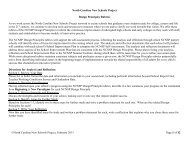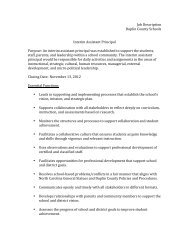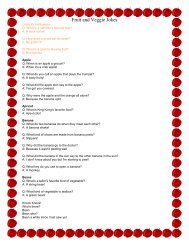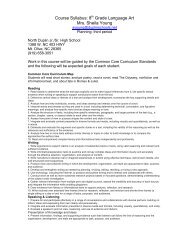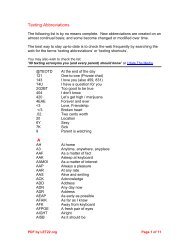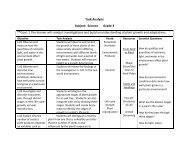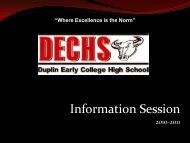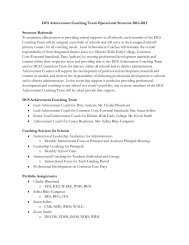NCNSP Design Principle Rubric - Duplin County Schools
NCNSP Design Principle Rubric - Duplin County Schools
NCNSP Design Principle Rubric - Duplin County Schools
You also want an ePaper? Increase the reach of your titles
YUMPU automatically turns print PDFs into web optimized ePapers that Google loves.
College Credit College Ready Skills(High School)Course of Study<strong>NCNSP</strong> <strong>Design</strong> <strong>Principle</strong> 1: Ready for CollegeBeginning Early Steps Growing Innovations New ParadigmsStudents are tracked according to pastperformance into regular and honorslevel courses.All students are given the option to takeat least one honors course.All courses are taught at the honorslevel where applicable in the NCSCOS.Every student graduates with theminimum admissions standards for theUNC system schools.Students are allotted time to receiveacademic assistance (i.e. regularscheduled meeting with staff member,tutorials).During and after school support isscheduled on an individual basis,determined by student performance anddata.<strong>Schools</strong> implement the academicsupports necessary for every student tosucceed in the university prep/futureready core curriculum.<strong>Schools</strong> revise high school experienceof current students based on datacollected from college going graduates.A curriculum integrating but not limitedto self-advocacy, note taking skills,study skills, research skills, written andoral communication, self monitoringand time management (college readyskills) exists.College ready skills are implementedthroughout the curriculum.Opportunities for students to practicecollege ready skills are provided viaexhibitions, presentations (projectgraduation) to authentic audiences.Every student experiences a curriculumthat requires self-advocacy, note takingskills, study skills, research skills,written and oral communication, selfmonitoringand time management.Students are unaware of collegeresources available to them, e.g. studygroups, tutoring center, library andoffice hours.Students develop a four/five year planduring the freshman year.Selected students enroll in some collegeclasses.Some students use college resources.Students review their four/five yearplan occasionally with a staff member.Most students enroll in some collegeclasses, selected by interest only.Every student learns how to makeeffective and efficient use of collegeresources.Each student has a well-definedfour/five year plan that is continuallymonitored and updated to ensurecompletion of an AA or AS degree, ortransferrable college credit.All students are enrolled in andcomplete college classes withtransferable credit.Every student is an advocate for theirown learning, seeking opportunities forpersonal growth and success in thecollege environment.Every student is accepted into a fouryear institution with credits earned fullyrecognized. Students’ acceptance tocollege is celebrated.Every student graduates high schoolwith both a high school diploma and atwo year degree or 64 hours oftransferable credit.©North Carolina New <strong>Schools</strong> Project, February 2011 Page 1 of 13
College Going Culture<strong>NCNSP</strong> <strong>Design</strong> <strong>Principle</strong> 1: Ready for CollegeBeginning Early Steps Growing Innovations New ParadigmsStudents and families are invited toorientation/open house at the home basecommunity college or university.Brochures and literature about financialplanning and scholarships are availablefor students.Some students take the SAT at somepoint.A list of institutes of higher education isposted in the counselor’s office.Displays throughout the schoolhighlight colleges. Students aspire toattend college.Students are given the opportunity toparticipate in optional college visits.Families are invited to presentationabout FAFSA, CFNC, scholarships, andthe college admissions process.Students have access to take the PSATand SAT in sequence and on time.Teachers post information about theircollege(s) and invite students to discusstheir college experience. Frequentconversations exist between studentsand teachers with a focus on attendingand graduating college.Multiple mandatory visits to four yearinstitutions take place throughout theyear.Families are supported through FAFSAand scholarship application processeson site.Students are given multipleopportunities to prepare for andparticipate in the PSAT/SAT/ACT.Students explore the internet andinvestigate possible institutions basedon their interests. Teachers and studentstalk daily about acquiring tangible goalsin order to go to college. Conversationsfocus on which college to attend notwhether to go to college.Every student and their family visitmultiple IHE campuses throughout theyear.<strong>Schools</strong> provide support for everystudent and family for collegeadmissions and financial aid, includingscholarship applications.Every student takes the PSAT andSAT/ACT in sequence and on time.Every student completes a formalprocess through which they aresupported by staff in applying to andbeing accepted at multiple IHEs.©North Carolina New <strong>Schools</strong> Project, February 2011 Page 2 of 13
InstructionCurriculum<strong>NCNSP</strong> <strong>Design</strong> <strong>Principle</strong> 2: Require Powerful Teaching and LearningBeginning Early Steps Growing Innovation New ParadigmsTeachers plan using a variety ofresources but without reference to local,state or national standards or withoutconsideration of appropriate pacing.Content is course-specific.There are limited learning activitiesoutside of classroom experiences.Instruction meets the learning needs ofsome, but not all, students.There is limited use of technology forinstruction.Teachers provide limited opportunitiesfor students to work in groups.Teachers teach the North CarolinaStandard Course of Study at anappropriate pace.Teachers relate the content from othercourses to connect learning for studentsand incorporate literacy and problemsolving instruction within each contentarea or discipline.Some teacher-directed learningactivities enrich classroom curricula forsome students.Teachers regularly adapt resources andinstruction to address learningdifferences in their students.Teachers integrate and use technologyin their instruction.Teachers organize student learningteams and teach the importance ofcooperation and collaboration.Teachers plan instruction around “bigideas” that are mapped to multiplestandards and to 21 st century skills (e.g.leadership, ethics, accountability,adaptability, initiative, communication,collaboration, social responsibility,wellness, entrepreneurship).Teachers relate the content to otherdisciplines and school theme (ifapplicable) to deepen understanding andconnect learning for students, acrosseach school year as well as from year toyear. Teachers further promote globalawareness and its relevance to thesubjects they teach.All students participate in purposefuland varied co-curricular learningopportunities that support college andwork readiness and school theme (ifapplicable).Teachers create structures forpersonalized learning and teach studentsto make informed choices.Teachers know when and how to usetechnology to maximize students’development of critical-thinking andproblem-solving skills.Teachers organize learning teamsdeliberately and teach students how tocreate and manage their own teams.Students identify problems – in theirown lives, in their communities, and inthe world – and design projects mappedto state and national standards acrossdisciplines.Students synthesize relevant knowledgeand skills from their cumulativeexperience to design and communicatethoughtful solutions to increasinglysophisticated, authentic problems. Inthemed schools, authentic problemsrelate to school theme.Students design and lead a wide rangeof co-curricular learning opportunitiesthat support college and work readiness,service learning and school theme (ifapplicable).Students create their own learning planswith guidance and support from theteacher.Students help each other use technologyto learn content, think critically, solveproblems, discern reliability, useinformation, communicate, innovate andcollaborate.Students effectively organize andmanage their own learning teams.©North Carolina New <strong>Schools</strong> Project, February 2011 Page 3 of 13
AssessmentInstruction<strong>NCNSP</strong> <strong>Design</strong> <strong>Principle</strong> 2: Require Powerful Teaching and LearningBeginning Early Steps Growing Innovation New ParadigmsTeacher talk dominates instruction.There is limited use of studentengagement strategies.Teachers post learning objectives.Teachers’ use of a narrow range ofassessment strategies limits theirunderstanding of students’ knowledgeand skills.Teachers primarily use assessments toassign grades and/or control behavior.Teachers provide limited feedback tostudents and/or parents regardingstudent progress. Feedback is limited togrades and/or assignment completion.Teachers communicate effectively withall students. Teachers help studentsarticulate thoughts and ideas clearly andeffectively.All teachers adopt a commoninstructional framework to makeinstruction more engaging for allstudents and to ensure a coherent andconsistent student learning experience.Teachers communicate learningoutcomes and the criteria for successand assess progress daily.Teachers employ varied assessmentstrategies that elicit student thinkingrelated to learning outcomes. Teachershave a more complete understanding ofstudents’ knowledge and skills.Teachers provide instructionalinterventions based on data fromassessments.Teachers regularly provide feedback tostudents and parents regarding progresson specific learning outcomes.Teachers teach students how tocommunicate effectively with eachother and set up classroom practices thatrequire them to do so. Collaborationand discussion among students ispervasive.Teachers facilitate students reading,writing, thinking and talking daily todevelop a deep understanding of coreacademic concepts.Teachers routinely share rubrics withstudents that clearly communicatemeaningful learning outcomes andcriteria for success. Teachers monitorprogress throughout each lesson.In addition to a wide range of teacherdesignedassessment strategies, teachersuse protocols for peer- and selfassessmentaligned to learningoutcomes and criteria. Teachers have acomprehensive understanding ofstudents’ knowledge and skills.Teachers provide timely, targetedopportunities for students to learn anddemonstrate particular outcomes basedon data from assessments.Teachers provide feedback to studentsand parents that clearly communicatestudents' strengths and specific guidancefor continued development relative tolearning outcomes.Students help each other exercise andcommunicate sound reasoning,understand connections, make complexchoices, and frame, analyze, and solveproblems. Students clarify ideas andother students’ work during whole-classdiscussions and small group work.Students ask each other to justify theirthinking.Students are reading, writing, thinkingand talking in every classroom everyday, without explicit teacher direction,to advance collective and individualunderstanding of core skills andconcepts.Students participate in the developmentof the criteria for successfuldemonstration of meaningful learningoutcomes.Students exercise choice in determininghow to demonstrate learning outcomes.Teachers and students share acomprehensive understanding of eachstudent’s knowledge and skills.Students monitor their progress onlearning outcomes and engage inmultiple, varied opportunities to learnand demonstrate outcomes.Teachers and students have ongoingcommunication regarding progresstoward learning outcomes and nextsteps.Students regularly report strengths andplans for continued developmentrelative to learning outcomes to parents.©North Carolina New <strong>Schools</strong> Project, February 2011 Page 4 of 13
Affective and Academic Supports<strong>NCNSP</strong> <strong>Design</strong> <strong>Principle</strong> 3: PersonalizationBeginning Early Steps Growing Innovation New ParadigmsSome planning for implementation ofadvisories/seminars exists.There is a plan to develop relationshipswith the students, staff, and communitypartners and any higher educationpartners.Some online courses are available forstudents.There is a plan to develop academicsupport programs in order to maximizestudent growth.Advisory courses are provided for somegrade levels.A systemic plan is followed in whicheach student is assigned to a teacheradvisor.The school counselor alsoserves as an advisor and assists studentswith their academic and affective needs.A variety of online courses are availablewhich students may take based on theiracademic needs.Some academic supports are in placesuch as a summer bridge program andtutoring session times available beforeand after school.Advisory/seminar courses with welldeveloped curricula exist for everygrade level.Advisories, personal learning plans,AVID or other school-wide strategiesare used to know students and theiracademic and affective needs well. Inaddition, staff members meet regularlyduring scheduled times to discussstudents’ academic and affective needs.There is a wide range of online coursesavailable to students based on theirpersonal interests and academic needs.Academic support programs are in placeduring the summer and before, during,and after the school day such as tutoringsessions and academic support labs.There is an advisory or seminar coursefor every grade level that providesstudents with affective and academicsupports based on students’ personallearning plans and other data.A schedule is in place in which schoolstaff and college staff from any highereducation partners meet regularly todiscuss students’ progress. Data is usedto identify and implement the necessarysupports for students.The school provides a wide range ofhigh school and college courses thatallow students to be self-initiated andself-paced. Supports are available thathelp students to complete these coursesat a high rate of success.The school schedule provides variedopportunities for students to obtainadditional supports through extendedblocks, looping, tutoring and summerprograms.©North Carolina New <strong>Schools</strong> Project, February 2011 Page 5 of 13
Adult/Student Relationships<strong>NCNSP</strong> <strong>Design</strong> <strong>Principle</strong> 3: PersonalizationBeginning Early Steps Growing Innovation New ParadigmsA welcome letter is sent to incomingfreshmen.Some teachers meet occasionally todiscuss the needs and progress ofstudents.Staff members visit the homes ofincoming freshmen.There is a plan to develop a schoolschedule that provides time for teachersto meet at least once a week to discussthe needs and progress of students.Staff members visit the homes ofincoming freshmen and new students towelcome them and begin developingpositive relationships.All teachers meet weekly by grade levelor subject area to discuss the needs andprogress of students.Staff members visit the homes of everystudent annually in order to maintainpositive parent-school relationships anddiscuss the needs and progress ofstudents.Teachers are grouped by students andmeet during scheduled commonplanning times daily to discuss studentneeds and develop supports.Every student has a teacher-advisor.During informal conversations, studentsstate that they feel their teachers careabout them.Teacher-advisors meet with theirassigned students once a month.Data gathered from sources such asstudent surveys indicate that a majorityof students feel known and cared for bythe adults in their school.Teacher-advisors meet with theirassigned students weekly to review theiracademic progress.A school wide survey of the studentbody indicates that at least 95% ofstudents surveyed indicate that they feelknown, respected and cared for.Teacher-advisors meet with assignedstudents at least once a week to reviewtheir progress and provide academicand affective supports as needed.Teacher-advisors are looped to advancewith students as they advance throughhigh school and review the studentspersonal education plans in order toensure successful completion.Data from surveys of students andparents indicate that at least 98% ofboth populations feel that the adults inthe school care, know, and respectthem.The school distributes newsletters orother forms of communication toprovide updates and informationfrequently.School newsletters and communicationsare provided in a language other thanEnglish.School newsletters and communicationsare translated into every languagerepresented in the student population.The school website, blogs, tweets,social media sites and newsletters aretranslated into every languagerepresented in the school and are madeavailable. Parents, students and othercommunity members are also involvedin submitting information for thenewsletters and communications.©North Carolina New <strong>Schools</strong> Project, February 2011 Page 6 of 13
Shared Responsibility and CollaborativeDecision MakingCollaborative Work Orientation<strong>NCNSP</strong> <strong>Design</strong> <strong>Principle</strong> 4: Redefine ProfessionalismBeginning Early Steps Growing Innovations New ParadigmsPrincipals observe teachers.Staff attends staff meetings and/orcommon planning opportunities, asappropriate.Teachers work independently.School implements district protocolsfor recruitment, interview and hiringprocesses.Teachers supervise advisories.Students are organized into advisorygroups and/or project teams.Professional development opportunitiesare offered to support youthdevelopment.Principals make decisions related toschool-wide issues and teachers makedecisions related to classroom issues.Teachers observe their peers inpractice.Staff meetings and/or commonplanning opportunities modelcollaboration among adults.Staff collaborates with peers and, attimes, share expertise for professionallearning and improved practice.Principal includes one or more staff inrecruitment, interview, and hiringprocesses for their specific school.Teachers are developed as teachercounselorsthrough a common researchbased approach to student development.Peer connections are promoted throughadvisory groups and/or project teamsTeachers share strategies for engagingchallenging students.Staff has some input into schooldecisions, including the selection ofrepresentatives to decision-makingbodies.Teachers observe their peers in practicefor the purpose of giving and receivingfeedback for revision and improvement.Staff meetings and/or commonplanning opportunities model inquiryamong adults.Staff regularly collaborates with peers,share expertise, and holds themselvesaccountable for professional learningand improved practice.Principal and staff collaborate onrecruitment, interview, and hiringprocesses to ensure alignment with theschool’s mission.Teachers lead advisories that provideconsistent guidance and support,including the development of personallearning plans and support foremotional, social and academic needs.Students have an overt and clearlydelineated mechanism for participatingin student development and schoolsuccess.Teachers collaboratively create flexiblesolutions for engaging challengingstudents.All staff work together to makedecisions that advance the mission ofthe school.All staff members solicit peer feedbackin order to advance their own practice.Staff is engaged in inquiry around theirpractice through sharing their work,student work and professionaldilemmas for feedback and support.Staff regularly collaborates with peers,share expertise, and hold themselvesand peers accountable for professionallearning and improved practice.Staff, parents, and students collaborateon recruitment, interview and hiringprocesses to ensure alignment with theschool’s mission.All adults in the school assumeresponsibility for youth developmentand each student’s success.Students assume responsibility forpositive school and communityengagement that contributes tocitizenship.The school actively engages familiesregarding successes and challenges thattheir child faces and works withfamilies to arrive at successfulsolutions.Individuals from all constituent groupsare engaged in and can clearlyarticulate the school decision-makingprocess and the avenues forparticipation.©North Carolina New <strong>Schools</strong> Project, February 2011 Page 7 of 13
Sustainability<strong>NCNSP</strong> <strong>Design</strong> <strong>Principle</strong> 4: Redefine ProfessionalismBeginning Early Steps Growing Innovations New ParadigmsKnowledge Capture & ExchangeStaff maintains personal classroom andinstructional resources and units ofstudy.NetworkingAssigned teachers participate inscheduled <strong>NCNSP</strong> network events.All staff share resources and units ofstudy with school-based peers.Teachers initiate participation inscheduled <strong>NCNSP</strong> network events.All staff post and use resources andunits of study in a shared best-practicelibrary.Staff participates in peer networks forthe purpose of giving and receivingfeedback to advance specific practices.All staff routinely vets individual andshared resources and units of studyposted in a shared best-practice librarywith school-based peers and with peersacross the <strong>NCNSP</strong> network.Staff convene and regularly networkwith peers, employers, and expertsbeyond the school.CommunicationStaff members sometimes speak insupport of the school with internal andexternal stakeholders.Staff members routinely speak insupport of the school with internal andexternal stakeholders.Staff members speak with confidenceabout collectively made decisions withinternal and external stakeholders.Staff members speak with confidenceto stakeholders about collectively madedecisions and their alignment with theschool’s mission and vision.Capacity BuildingSchool participates in <strong>NCNSP</strong>-providedprofessional development.<strong>Schools</strong> have a mechanism fordisseminating resources and materialsgarnered from <strong>NCNSP</strong> professionaldevelopment experiences.<strong>Schools</strong> secure resources andprofessional development experiencesaligned with the school’s mission andvision and <strong>NCNSP</strong> <strong>Design</strong> <strong>Principle</strong>s.<strong>Schools</strong> have a systematic, internalprocess for the on-boarding anddevelopment of new staff and crosstraining,capacity building, andcontinued acculturation of existing staffaligned with <strong>NCNSP</strong> <strong>Design</strong> <strong>Principle</strong>s.©North Carolina New <strong>Schools</strong> Project, February 2011 Page 8 of 13
Autonomous Governance<strong>NCNSP</strong> <strong>Design</strong> <strong>Principle</strong> 5: Purposeful <strong>Design</strong>Beginning Early Steps Growing Innovations New ParadigmsA full-time principal has been namedand essential staff has been hired.The school has a unique school codeand a preliminary school budget hasbeen prepared.The school has established an identityand theme.The district office is aware of theseparate professional developmentrequirements set forth by the <strong>NCNSP</strong>.Adequate instructional and support staffmembers have been hired. Along withthe principal, their time is not dividedwith other schools.The principal and staff meet to reviewand discuss the school budget.The school actively advertises theirschool’s identity and theme and visitsmiddle schools to recruit their targetpopulation.The district office has waived requiredattendance at some of the district levelprofessional development.The principal, instructional staff, andsupport staff meet consistently todiscuss scheduling and hiring decisionsas well as other school operation itemsin order to make decisions that will bestmeet students’ needs. The principaland staff members have significantautonomy from undesirable stafftransfers and district level professionaldevelopment mandates.The principal and staff meet frequentlyto discuss the school budget and makerevisions as necessary.The school is autonomous in makingdecisions regarding curriculumdecisions as related to the school’sidentity and theme.The district office and the schoolpartner are involved in the decisionmaking process regarding theattendance of the principal and staff forselected professional developmentevents.The principal and staff members workas a team in which distributedleadership is used and everyone isactively involved in key areas ofdecision making. The principal andstaff meet during scheduled, specifictimes at least once a week and use theirautonomy from district mandates tomake decisions and solve problems tocreate unique instructional designs tomeet student needs.The principal and staff meet on ascheduled basis to review the schoolbudget and make any necessaryrevisions. The budget is revised asnecessary to make decisions thatexemplify a flexible use of resources inthe best interests of students.The school reaches out to local, state,national and global organizations in todeepen the connection between theschool’s identity, theme, and real worldapplications.The principal and staff have completeautonomy in making decisionsregarding attendance at district levelprofessional development events. Theprincipal and staff attend andimplement all <strong>NCNSP</strong> mandatedprofessional development. They alsowork together to identify and developany additional professionaldevelopment needed.©North Carolina New <strong>Schools</strong> Project, February 2011 Page 9 of 13
Student Recruitment andSelection*School Sustainability<strong>NCNSP</strong> <strong>Design</strong> <strong>Principle</strong> 5: Purposeful <strong>Design</strong>Beginning Early Steps Growing Innovations New ParadigmsThere is a detailed budget plan onefiscal year prior to the current fiscalyear.The school is recognized in thecommunity.The school is well recognized by theschool district and local educationpartners.Recruitment materials for the schoolare available.A school admissions policy exists.The principal recruits in middleschools.There is a detailed five year budgetplan for the duration of initial funding.The school fosters relationships withbusiness and community partners forfinancial support, community serviceopportunities, job shadowingopportunities and participation inschool projects during the school year.The school has scheduled meetingswith the school district and highereducation partner to discusssustainability of the school.Recruitment materials are aligned with<strong>NCNSP</strong> guidelines for the specificmodel.The school admissions policy is welldefined and non-selective.The principal and staff recruit in middleschools.There is a detailed budget plan toensure program sustainability beyondinitial funding.The school develops business andcommunity partnerships for continuousfinancial support, community serviceopportunities, internship opportunities,and participation in school projects thatconnect to and influence decisionmaking.Short and long range plans fordevelopment and sustainability of theschool are available and supported bythe school district and higher educationpartner.Recruitment materials are aligned with<strong>NCNSP</strong> guidelines for the specificmodel in at least two languages.Some faculty members participateduring middle school recruitment visitsand presentations. The staffparticipates during the selectionprocess. A rubric for targetedrecruitment focused on the designprinciples is implemented.The principal, staff and studentsexplicitly reach out to underrepresentedparent and community groups.There is a detailed budget plan toensure program sustainability beyondinitial funding that incorporatesbusiness and community partnersupport as well as other stakeholders.The school develops business andcommunity partnerships for ongoingfinancial support, community serviceopportunities and participation inschool projects that connect to andinfluence decision making. Businessand community partners are also usedto provide opportunities that connectstudents to real world learningexperiences.A plan for the sustainability of theschool is embedded within the outlookof the school district and highereducation partner.Recruitment materials aligned with<strong>NCNSP</strong> guidelines for the specificmodel are available online in multiplelanguages.Faculty, staff, students and communityleaders assist the principal byparticipating during the selectionprocess. A rubric for targetedrecruitment and student interviews areused in the process.A community approach involving thestaff, parents, students, civic leadersand business leaders is executed toreach out to underrepresented parentand community groups.©North Carolina New <strong>Schools</strong> Project, February 2011 Page 10 of 13
Collaborative WorkOrientation<strong>NCNSP</strong> <strong>Design</strong> <strong>Principle</strong> 5: Purposeful <strong>Design</strong>Beginning Early Steps Growing Innovations New ParadigmsTeachers work independently.Staff members collaborate with peersand, at times, share expertise forprofessional learning and improvedpractice.Staff regularly collaborates with peers,share expertise, and holds themselvesaccountable for professional learningand improved practice. A commonplanning time has been established aspart of the master schedule.Staff regularly collaborates with peers,shares expertise, and holds itself andpeers accountable for professionallearning and improved practice.©North Carolina New <strong>Schools</strong> Project, February 2011 Page 11 of 13
Focus on PowerfulTeaching & LearningChange AgentSharedMission<strong>NCNSP</strong> <strong>Design</strong> <strong>Principle</strong> 6: LeadershipBeginning Early Steps Growing Innovations New ParadigmsThe principal employs tools to create amission and vision for the school.The principal completes the SchoolImprovement Plan and <strong>NCNSP</strong> Selfassessment.The principal allows teachers to takerisks in meeting students’ needs.The principal expects teachers to be apart of a professional learningcommunity.The principal safeguards instructionaland professional time in the school day.The principal collects or receives data.The principal ensures that the school’sidentity actually drives decisions andinforms the culture of the school.The principal ensures alignment of theschool’s vision with the implementationof evidence-based strategies to improvestudent performance.The principal and staff creatively seekopportunities to build new and uniqueconnections between the school and thecommunity.The principal convenes staff workinggroups to identify instructional trendsacross campus.The principal monitors instruction inclassrooms daily for full implementationof the Common InstructionalFramework and provides relevant andtargeted feedback to teachers.The principal makes data available tostaff for review and reflection.Staff members work together to makedecisions that advance the mission ofthe school and foster understandingamong constituent groups.The principal acts as a catalyst to seeknew solutions and encourages risktakingin meeting individual studentneeds with potentially beneficialoutcomes.The principal proactively developspartnerships with district andinstitutions (e.g., higher educationcolleagues) to the benefit of school andstudents.The principal leads discussions aboutstandards based upon research and bestpractice.The principal holds staff accountable forfull implementation of the CommonInstructional Framework and forcontinuous learning and professionaldevelopment.The principal facilitates conversationswith staff about the use of data toimprove school performance throughsystematic collection, analysis and goalsetting.Staff members engage in a dynamicprocess of continuous re-examinationand refinement of the mission of theschool in order to grow the school’sdirection based on previous successesand challenges.Staff assumes ownership for thedevelopment of new solutions to meetschool and individual student needs.The principal contributes to leadershipwithin the district and across the<strong>NCNSP</strong> network to advance aninnovative educational agenda for allstudents in North Carolina.Staff members assume ownership ofproblem identification, solutiongeneration and strategy implementation.Staff collaborates with peers, sharesexpertise, and holds itself and peersaccountable for professional learningand improved practice.Staff members adopt an action researchorientation that includes the collectionof data points, analysis, and goal settingas a result of data review.©North Carolina New <strong>Schools</strong> Project, February 2011 Page 12 of 13
Collaborative WorkEnvironmentShared LeadershipCulture of HighExpectationsThe principal believes that all studentsare capable, with appropriate supports,of succeeding in a challenging learningenvironment.<strong>NCNSP</strong> <strong>Design</strong> <strong>Principle</strong> 6: LeadershipBeginning Early Steps Growing Innovations New ParadigmsThe principal demonstrates evidence of The principal holds staff accountable forhigh expectations for all students that ensuring the success of each student.eliminates tracking.The principal believes that all staffmembers, with support, are capable ofcreating a rigorous and challenginglearning environment for all students.The principal makes decisions related toschool-wide issues.The principal leads all committees andwork groups.The principal develops partnershipswith staff to the benefit of the schooland students.The principal designs a schedule andprocess that includes common planningopportunities.The principal demonstrates evidence ofhigh expectations for all staff thatinclude routine conversations with staffregarding school standards for rigorousand challenging learning environmentsfor all students.The principal seeks input from staff intodecisions made at the school, includingactive recruitment of diverserepresentatives on school decisionmakingbodies.The principal actively encouragesteacher leadership through traditionalschool-based leadership opportunities,including department/grade levelleaders, School Improvement Chair, etc.The principal proactively developsrelationships with students, families andcommunity partners.Staff share instructional practices,lessons learned, and current challengeswith peers during common planningopportunities.The principal holds teachersaccountable for full engagement in thedesign and implementation of rigorousand challenging learning environmentsfor all students.The principal establishes a clearcollaborative decision-making processso that all staff work together asappropriate to make decisions thatadvance the mission of the school.The principal promotes staffparticipation in district and externalleadership opportunities and enablesstaff to lead school-based conversationsabout those experiences.Teachers, parents, and communitymembers actively participate in thedevelopment of the SchoolImprovement Plan, the <strong>NCNSP</strong> Selfassessment,and other school plans.Practice is made public through the useof school-wide rounds and peer schoolreview, which includes both internal andexternal peer observation and feedback.Staff holds peers accountable forensuring the success of each student.Staff collaborates with peers, sharesexpertise, and holds itself and peersaccountable for the design andimplementation rigorous andchallenging learning environments forall students.Individuals from all constituent groupsare engaged in and can clearly articulatethe school decision-making process andthe avenues for participation.The principal expects and empowersteacher leadership through theestablishment of clearly defined andpromoted leadership deploymentpathways.The principal empowers staff and schoolcommunity to assume ownership ofproblem identification, solutiongeneration and strategy implementation.Staff members routinely engage inquality assurance processes such asschool-wide rounds, peer school review,and collaborative student work reviewsto improve instructional practices withinspecific classrooms and across theschool.©North Carolina New <strong>Schools</strong> Project, February 2011 Page 13 of 13




